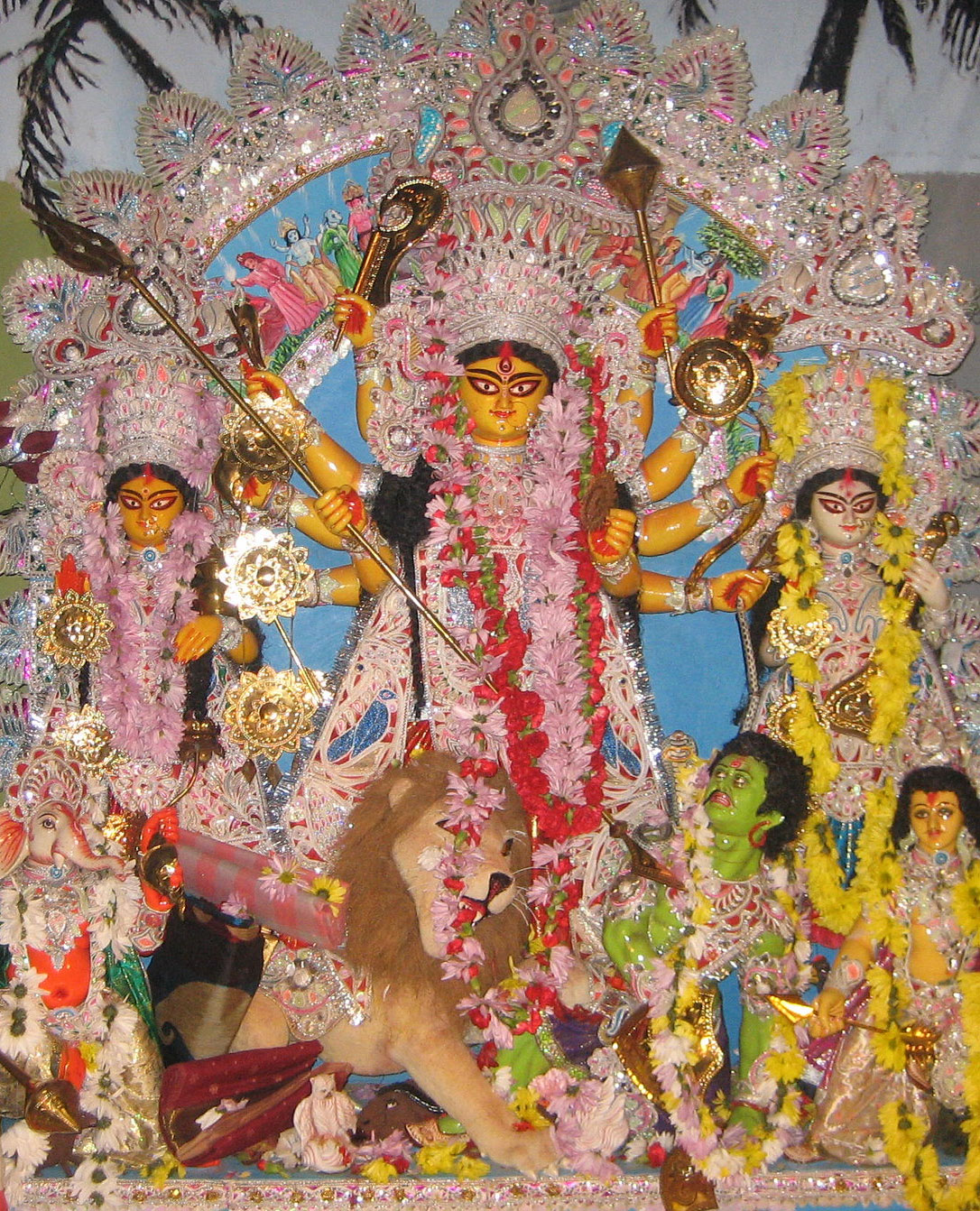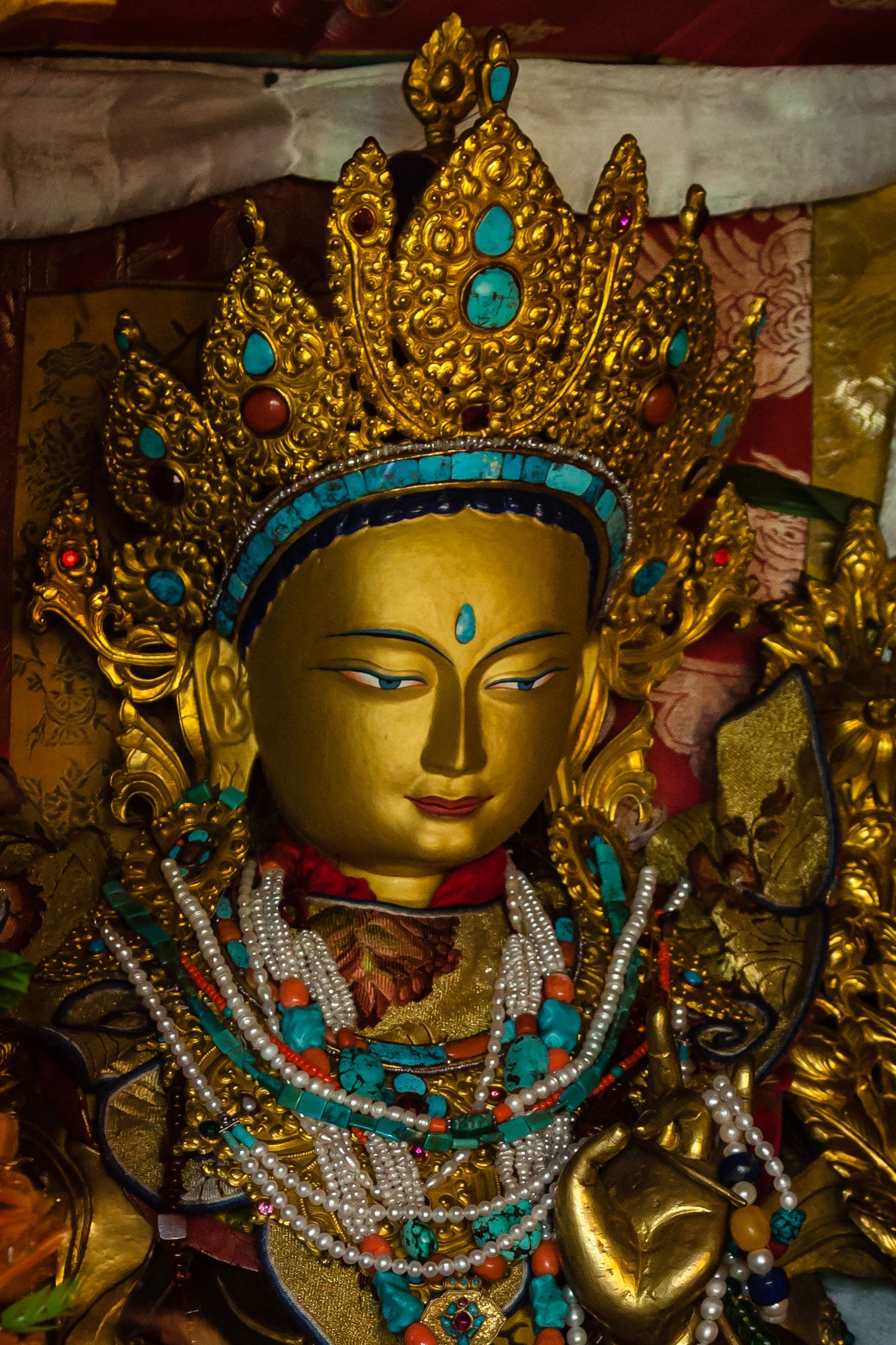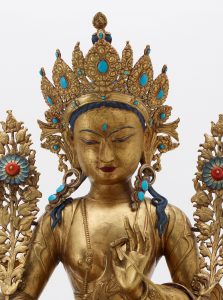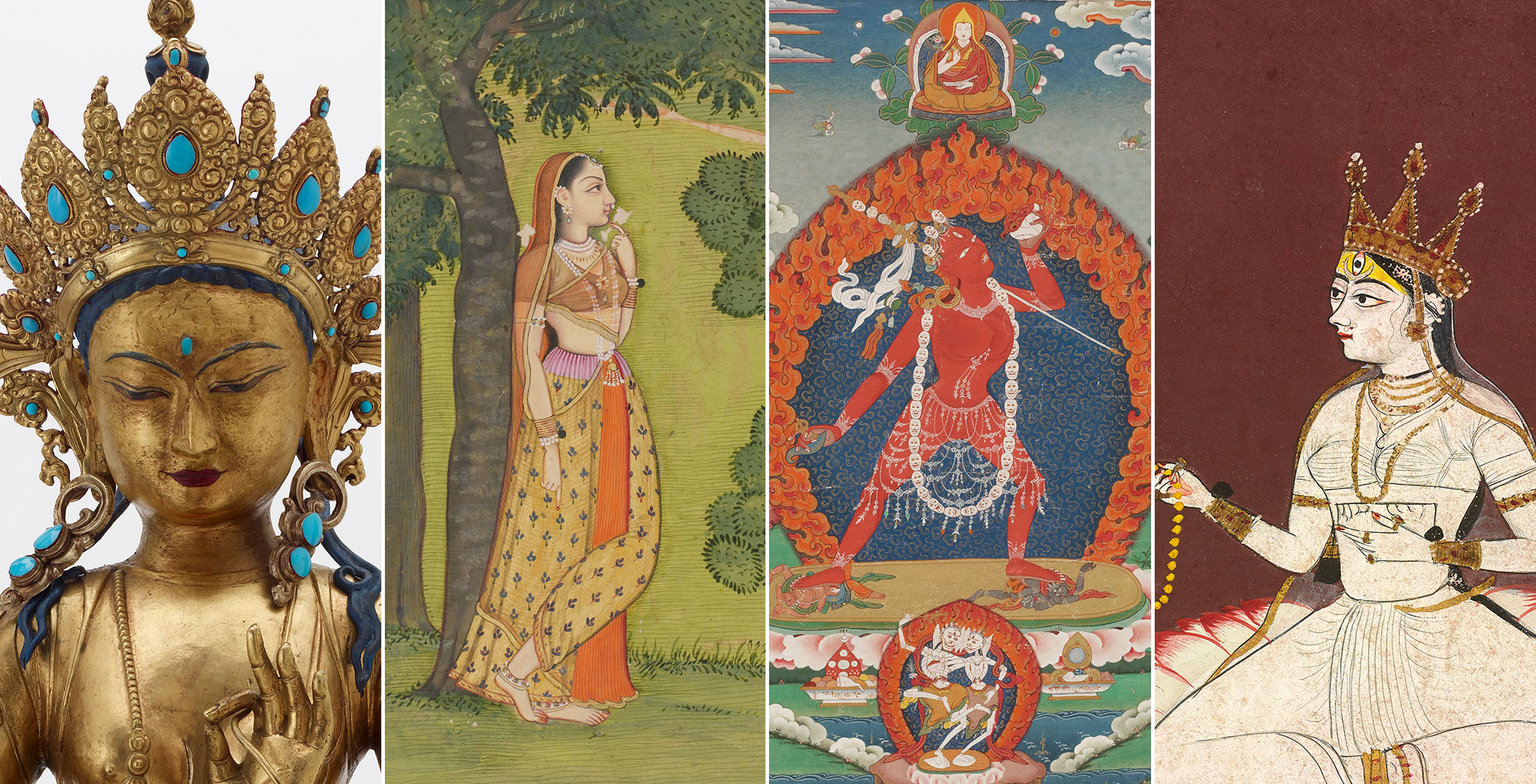Viewing Goddesses in Asian Art


Fig. 1. Goddess Minakshi of Madurai. Photo by Thiagarajan Kannan, licensed under CC BY-SA 3.0.
Image 1 of 5

Fig. 2. Durga Ma at the Bengali Association of South Florida’s Durga Puja Festival, 2010. Photo by Seaview99, licensed under CC BY-NC-SA-2.0.
Image 2 of 5

Fig. 3. Goddess Tara inside the Spituk Monastery, Leh, Ladakh, Northern India. Photo by Andrea Schieber, license CC BY-NC-ND 2.0 DEED.
Image 3 of 5

Fig. 4. White Tara (detail), copper alloy with inlays, National Museum of Asian Art, Smithsonian Institution, The Alice S. Kandell Collection, Arthur M. Sackler Gallery, S2011.12a–c
Image 4 of 5

Fig. 5. Twenty-One Taras. Photo by Kadampa Center of Tibetan Buddhism, Raleigh, NC, USA. CC BY-NC-SA 2.0 DEED.
Image 5 of 5
Introduction
The twenty-five artworks from the National Museum of Asian Art’s permanent collections in the Wisdom of the Goddess exhibition depict goddesses from the Buddhist and Hindu traditions of South Asia, the Himalayas, and Southeast Asia. Many of these objects were used in the past by individuals or by temples as aids for goddess worship. They all demonstrate incredible artistic skill and craftsmanship. This essay aims to place artworks from the exhibition into their intended contexts of worship and to outline the process of analyzing goddess imagery in Asian art. This helps us understand both the objects’ use-functions and, just as importantly, their immense artistic value.
Analyzing Religious Artworks
Studying visual culture, which encompasses works of art, is an essential way to learn about societies around the world. Looking closely at the artworks in the Wisdom of the Goddess exhibition can therefore help us understand the religious beliefs and practices of a specific place and time as well as how those beliefs and practices have evolved and endured over the centuries.
An artwork produced within the culture of a specific place and time is a primary source for study and research. When looking closely, we can “read” an object as a primary visual text that provides us with historical and cultural knowledge. An analysis is a detailed examination of the parts of something to better understand it as a whole. When analyzing an artwork, it is important to determine what can still be known about the object’s contextual use—in other words, the circumstances of its creation and how it was used. Questions that reveal contextual use include:
- Where and when was it made?
- Who made this artwork and why? It is important to note that the names of artists who created sacred images, often in a workshop setting, are rarely known—the artists did not sign their works.
- Who commissioned (or paid for) it, and why? What did it mean to them?
- What was/is its intended purpose or use?
- What did it mean to the people who used it or to its broader devotional community?
An artwork’s visual, or formal, elements include everything we can understand through close viewing. An object’s style, for example, encompasses how an artist creates the forms of an artwork in culturally specific and/or individualistic ways. Keep in mind that style can also help create meaning for the viewer. Another formal element that gives clues to an artwork’s meaning is its iconography, a set of symbols related to a particular deity and/or the broader historical context. By asking questions, not only can we better understand the artwork and its historical context but we can also identify visual aspects of each goddess artwork that are similar to or different from aspects of goddess images that were important in other times and places. We can also connect historical goddess images to similar cultural contexts and religious practices that exist today.
A tenth-century bronze sculpture of the Hindu goddess Uma is an example of a religious artwork from a specific time and place that has endured through ten centuries (that’s one thousand years!). Watch National Museum of Asian Art curator Dr. Emma Natalya Stein and Dr. Beth Harris weave together contextual use and artistic significance in their analysis of the remarkable artwork in this video. Afterward, try to connect the information about the sculpture of Uma they provide with each of the questions listed above. For example, how was the sculpture used?
Religious Art in Context: Goddesses in Hindu Traditions


Religious Art in Context: Goddesses in Buddhist Traditions

With the rise in popularity of Mahayana (or “Great Vehicle”) Buddhism in the middle of the first millennium CE, goddesses took on more central roles in the ritual and visual cultures of Indian Buddhism. By developing their spiritual wisdom and a sense of great compassion, devoted practitioners of Mahayana Buddhism chose to take the vows of a bodhisattva, a person who aspires to become a future buddha so that they might aid beings in samsara. Texts also describe goddesses who take bodhisattva vows. High-level bodhisattvas are no longer subject to rebirth in samsara but instead reside in celestial buddha fields, also known as Pure Lands, and endlessly manifest on earth to aid beings.


The Artistic Significance of Goddess Artworks
The White Tara sculpture from seventeenth-century Tibet in the Wisdom of the Goddess exhibition provides valuable historical evidence. While the sculpture is golden, Tara’s iconography—including her upraised hand gesture, which represents teaching or discussion, and the vase containing the nectar of immortality that she holds—signals that she is in her White Tara form as a giver of long life and compassionate healing. This regal artwork was created through a technique called repoussé. When using this technique, the artist first shapes the three-dimensional contours of the sculpture by hammering copper sheets, as this video of a Tibetan artist in north India demonstrates. The artist then assembles the sculpture from multiple hammered and fire-treated segments and gilds and paints the surface before adding inlays of semiprecious stones.
The artist who expertly crafted this White Tara sculpture employs a style that evolved over the course of more than nine hundred years of sculpture-making in the Himalayan region, and that developed out of a gradual cross-pollination of various regional styles. The elegant forms of painted wood and gilded bronze sculptures created during the Malla dynasty’s reign in Nepal (1202–1779), which drew from earlier Pala-period styles from northeastern India and Bangladesh (from the eighth to the twelfth century), doubtlessly influenced Tibetan craftsmanship. Nepalese artists are also known to have worked in Tibet. Furthermore, a vibrant western Tibetan/Kashmiri sculptural tradition ran parallel to those of Nepal and eastern Tibet, with a distinctive and influential style of its own. From the Yuan dynasty (1271–1368) onward, Tibetan Buddhist teachers (lamas) closely interacted with rulers of China, and Tibetan art began to take on Chinese stylistic elements as well. This ceramic work (ca. 1600–1700), created during the Qing dynasty (1644–1911), has resonances with Tibetan art with its tendrils of weightless, curling fabric snaking upward like smoke. Multiple lineages of cross-traditional artistic styles merged into an apex of Tibetan style by the seventeenth century, evoking a sense of exquisite regality in Tibetan deity images that rivals the masterpieces of earlier artistic production.
Conclusion: Putting It All Together
This essay focuses on the ways in which these skillfully made artworks represent the cultures and times in which they were created and how they help us better understand religious practices through visual analysis. Review the featured goddesses on the Wisdom of the Goddess exhibition page and how wisdom connects with their power. Then, for your own analysis, describe the visual aspects of an artwork from this exhibition that inspires you. Consider the materials and methods the artist uses. Also carefully consider the artist’s use of style, colors, and textures. How might these formal elements work together with what you’ve learned about the religious tradition of this goddess to create an impact on you, the viewer?
Selected Online Resources
- For a discussion of issues of provenance and how the National Museum of Art collects artworks, read about our World War II–era provenance research and 2023 provenance symposium.
- For a thorough overview of goddess artworks in the NMAA collections and in other museum collections, see Vidya Dehejia and Thomas B Coburn, Devi: The Great Goddess: Female Divinity in South Asia (Washington DC: Arthur M. Sackler Gallery, Smithsonian Institution in association with Mapin Publishing, Ahmedabad and Prestel Verlag, Munich, 1999).
- For Chola-style bronze casting in Thanjavur, India, today, see this video produced by Indica pictures.
- For a complete discussion of a Hindu puja ceremony for the goddess Mariamman, see Stephen Huyler, “The Experience: Approaching God,” in The Life of Hinduism, ed. John Stratton Hawley and Vasudha Narayanan (Berkeley: University of California Press, 2006). Read an excerpt here.
- For a further look at repoussé work, including a life-size Naro Dakini sculpture, see this video about Newar artists from Nepal.
- For a discussion of the popular Chinese bodhisattva-goddess Guanyin, who originated in South Asia as the male bodhisattva Avalokiteshvara, see Karen Lucic, Embodying Compassion in Buddhist Art: Image, Pilgrimage, Practice, exhibition catalog (New York: Francis Lehman Loeb Art Center, 2015).
Further Reading
For general audiences:
Harding, Elizabeth U. Kali: The Black Goddess of Dakshineswar. Delhi: Motilal Banarsidass, 1998.
Kinsley, David R. Hindu Goddesses: Visions of the Divine Feminine in the Hindu Religious Tradition; with a New Preface. Berkeley: University of California Press, 1986.
Sen[a], Ramprasad. Grace and Mercy in Her Wild Hair: Selected Poems to the Mother Goddess. Translated by Leonard Nathan and Clinton B. Seely. Prescott, AZ: Hohm Press, 1999.
Willson Martin. In Praise of Tārā: Songs to the Saviouress: Source Texts from India and Tibet on Buddhism’s Great Goddess. Boston: Wisdom Publications, 1996.
For higher education:
Beyer Stephen. The Cult of Tārā: Magic and Ritual in Tibet. Berkeley: University of California Press, 1978. Reprinted in 2020. https://doi.org/10.1525/9780520343153.
Dimmitt, Cornelia and J. A. B. van Buitenen, Classical Hindu Mythology: A Reader in the Sanskrit Purāṇas. 1st Indian ed. Delhi India: Sri Satguru Publications, 1998.
Hatley, Shaman. “Converting the Ḍākinī.” In Tantric Traditions in Transmission and Translation, edited by David B. Gray and Ryan Richard Overbey, 37. New York: Oxford University Press, 2016.
Hawley, John Stratton, and Donna Marie Wulff. Devī: Goddesses of India. Berkeley, CA: University of California Press, 1996.
Hawley, John Stratton, Donna Marie Wulff, and Harvard University Center for the Study of World Religions. The Divine Consort: Rādhā and the Goddesses of India. Berkeley: Berkeley Religious Studies Series, 1982.
Keul, István. ‘Yogini’ in South Asia: Interdisciplinary Approaches. London: Routledge, 2013.
McDermott, Rachel Fell, and Jeffrey J. Kripal. Encountering Kali: In the Margins, At the Center, In the West. Berkeley: University of California Press, 2003.
Simmer-Brown, Judith. Dakini’s Warm Breath: The Feminine Principle in Tibetan Buddhism. Boulder, CO: Shambhala, 2001.
Simmons, Caleb, Moumita Sen, and Hillary Rodrigues. Nine Nights of the Goddess: The Navarātri Festival in South Asia. Albany: State University of New York Press, 2018.
Related Exhibition
-

Wisdom of the Goddess
View the ExhibitionIt is often said that knowledge is power. For the goddesses of South Asia, Southeast Asia, and the Himalayas, power is closely connected to a particular type of divine wisdom or a state of omniscience, of knowing all things. This online exhibition highlights nine well-known goddesses of Hindu and Buddhist traditions through twenty-five artworks dating from the ninth through the nineteenth centuries, all drawn from the National Museum of Asian Art’s permanent collections.

